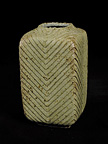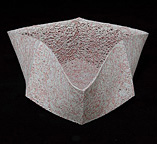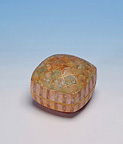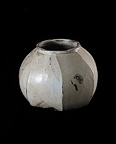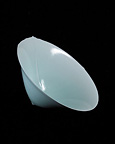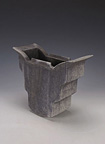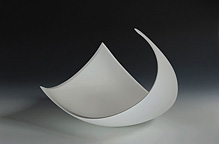Traditional artists look more to the past for inspiration, though they may draw from many sources – porcelain and stoneware, glazed wares and unglazed, celadons imported from Korea and China, tea bowls redolent of Oribe, Shigaraki, Bizen or any number of other styles, and their work tends to fall into the functional category. Tea ware, one of the most important ceramic genres, is often inspired by Momoyama prototypes, typically roughly formed vessels with complex glazes. Innovations occur but shapes tend to be traditional and form necessarily follows function.
One of the most traditional artists represented in this exhibition was in fact born in Germany. Gerd Knapper (born 1943), first came to Japan in 1967 and apprenticed with Suzuki Seisei and Shimaoka Tatsuzo, before establishing his own kiln in 1969. Early in his career, he distinguished himself by winning first prize in the Traditional Japanese Ceramic Art section at the first Japan Ceramic Art Competition in 1971 and has since become a significant figure in the ceramic arena. Knapper’s work is mostly functional, employing traditional shapes and techniques, such as poured and ash fired glazes, in the manner of Hamada Shoji, Kawai Kanjuro, et al. However, they are at the same time modern, incorporating non-traditional designs, such as the chevron patterns and Ban Chang (Thailand) inspired swirls that Knapper carves into many of his pieces.
By contrast, Nagae Shigekazu (born 1953) demonstrates a more radical break with tradition. His work is characterized by innovative techniques and forms, as well as a total disregard for traditional colors and glazes. Nagae drips liquid slip into molds to create designs evocative of Jackson Pollack. These shapes are then allowed to deform in the kiln, an effect redolent of many traditional wares where random kiln effects are often prized, demonstrating a synthesis of both eastern and western, and ancient and modern values.
Yukio Yoshita was born in Ishikawa Prefecture in 1960. He is a graduate of both the Kanazawa College of Art, where he is now a part time professor, and Kutani-Yaki Technical Training Institution. He has won numerous awards and prizes in juried exhibitions in Japan, where his work has been widely shown in various galleries. He works in porcelain to which he applies complex glazes. The piece shown here is typical in demonstrating his use of warm, faded-looking pastel colors. He uses very thin multiple applications of multicolored glazes and gold to give a rich layered texture to his work, which must undergo multiple firings between glazings.
Yoshihiko Yoshida (born 1936) is traditional artist who nonetheless also manages to invoke a contemporary feel in his work. He was a pupil of the renown potter Arakawa Toyozo, where he apprenticed for thirteen years until starting his own kiln in 1969. His work is recognized particularly for the subtlety of his glazes. In the work shown here, he has paddled a thrown bowl into a six sided form and applied a Shino glaze with understated iron glaze markings.
Another type of continuity is seen in the sculptures of Fukami Sueharu (born 1947). Fukami works in seihakuji or pale blue-green celadon glazed porcelain. Celadon wares, long prized in Japan since they were invented by the Chinese in the 11th or 12th century, have been made in Japan since the 16th century and have been appreciated there ever since. Yet while some of Fukami’s subject matter, such as his oversized sword blades, is informed by Japanese tradition, his elegant sculptures clearly reflect an international style. Constantly refining his shapes, his work is noted for its technical perfection. Fukami, who likes to inspire his viewers by giving his sculptures big titles, like “Cosmos” and “Hope,” is on record as saying that he has tried to remove any evidence that his hands ever touched the clay.
The young artist Takahashi Kazuya (born 1978), concentrating, like Fukami, on pure form, creates graceful rhythmic shapes inspired more by modern Western design than traditional Japanese elements. Clean, dramatic lines are often highlighted with sharp angled edges distinguishing his slip cast works in unglazed porcelain.
In contrast, there is the spare, spiritual work of Mihara Ken (born 1958). His restrained but varied shapes evoke a sense of harmony that emphasizes the quality of the clay. Mihara’s hand built works are first fired at low temperature and then covered with fire resistant clay before being high fired. When after firing the outer covering is removed, the austere character of the unglazed stoneware is revealed.
Finally, we present the very contemporary work of Kamei Yoichiro (born 1974). In 2001, Kamei became the second youngest person ever to win the Grand Prize at the prestigious Asahi Ceramics Fair. His work was chosen both for his totally original architectural concept and for the technical achievement of joining complex porcelain bodies.
I have tried in this brief introduction to show the diverse yet some-how coherent qualities inherent in modern Japanese ceramics. Japanese ceramicists today draw freely from the most ancient traditions and the most modern elements of design, technique and materials. In particular, I have tried to highlight the East-West dialogue that informs much of this work.
Fortunately, in recent years this dialogue is increasingly being conducted in America with Museum exhibitions – three notable examples are included in the bibliography – through art galleries, through a growing literature and, not least, in the work of many American ceramicists whose efforts have been influenced by the East just as artists in Japan have been influenced by the West.
